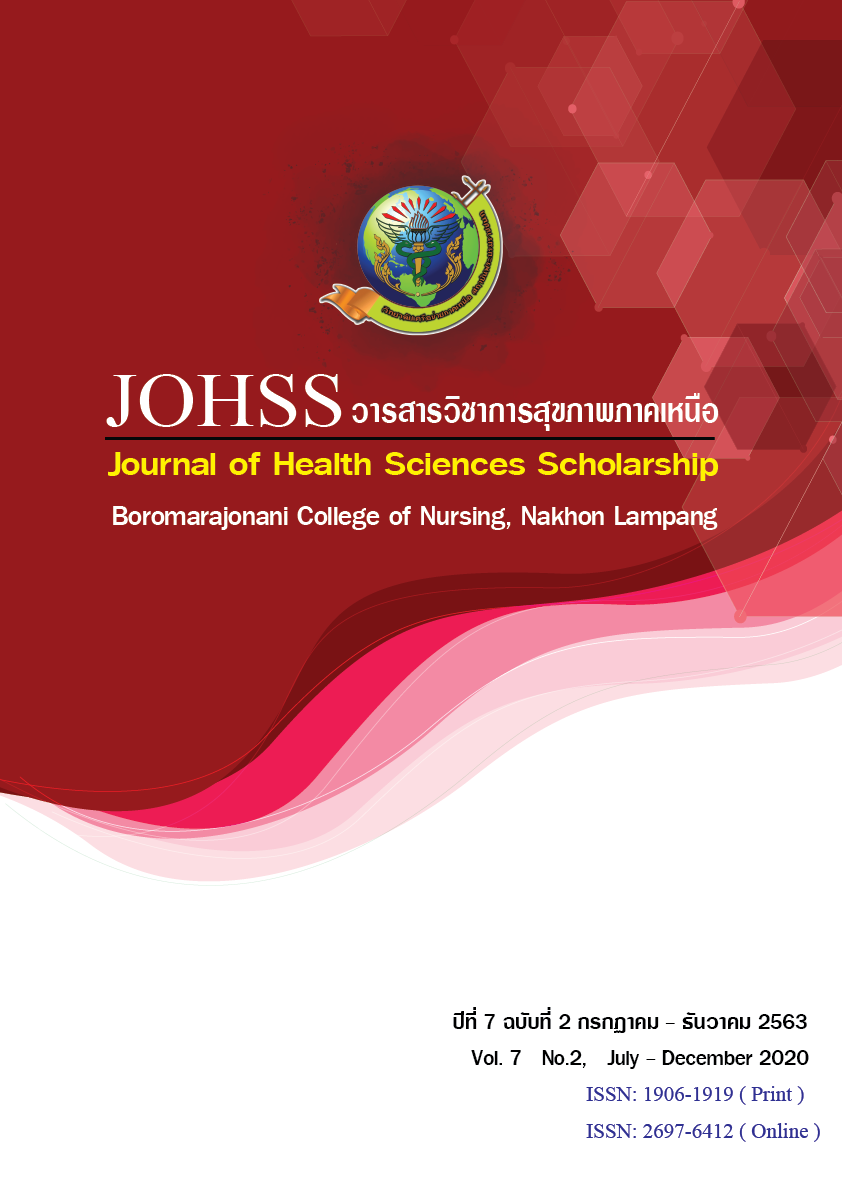การประยุกต์ใช้การเรียนรู้ร่วมระหว่างวิชาชีพผ่านการเยี่ยมบ้านของนักศึกษาพยาบาลศาสตร์และนักศึกษาเภสัชศาสตร์
คำสำคัญ:
การเรียนรู้ร่วมระหว่างวิชาชีพ, นักศึกษาพยาบาลศาสตร์, นักศึกษาเภสัชศาสตร์, การเยี่ยมบ้าน, การดูแลผู้สูงอายุบทคัดย่อ
การวิจัยและพัฒนาครั้งนี้มีวัตถุประสงค์เพื่อพัฒนารูปแบบการเรียนรู้ร่วมระหว่างวิชาชีพในการบริการสุขภาพผู้สูงอายุที่มีภาวะเจ็บป่วยเรื้อรังผ่านการเยี่ยมบ้านและเพื่อศึกษาผลของการใช้การพัฒนารูปแบบการเรียนรู้ร่วมระหว่างวิชาชีพในการให้บริการสุขภาพผู้สูงอายุที่มีภาวะเจ็บป่วยเรื้อรังผ่านการเยี่ยมบ้านของนักศึกษาพยาบาลและนักศึกษาเภสัชศาสตร์ โดยอาจารย์ผู้สอนทั้งสองหลักสูตรร่วมวิเคราะห์สภาพการณ์ปัจจุบัน (Analysis: A) ในการเรียนการสอนแบบเรียนรู้ร่วมระหว่างวิชาชีพ ประชุมวางแผนการออกแบบและพัฒนารูปแบบกิจกรรม(Design and Development: D & D) ในการเรียนรู้ร่วมกันสำหรับวิชาชีพพยาบาลและเภสัชกร นำรูปแบบกิจกรรมการเรียนรู้ร่วมกันระหว่างวิชาชีพไปใช้ (Implementation: I) โดยให้นักศึกษาทั้ง 2 หลักสูตร ให้บริการสุขภาพผู้สูงอายุที่มีภาวะเจ็บป่วยเรื้อรังผ่านการเยี่ยมบ้านผ่านวิชาปฏิบัติการโครงงานพัฒนาสุขภาพ หลักสูตรพยาบาลศาสตร์และวิชาเภสัชสาธารณสุข หลักสูตรเภสัชศาสตร์ในภาคการศึกษาที่ 2 ปีการศึกษา 2560 และประเมินผลการใช้รูปแบบกิจกรรมการเรียนรู้ร่วมระหว่างวิชาชีพ (Evaluation: E) จากข้อมูลของกลุ่มตัวอย่างในการเขียนสะท้อนคิด และผู้วิจัยนำมาวิเคราะห์เชิงคุณภาพ
ผลการวิจัยพบว่า รูปแบบการเรียนรู้ร่วมระหว่างวิชาชีพจำเป็นต้องคำนึงถึงลักษณะรายวิชา คุณลักษณะผู้เรียนและผู้สอนที่สอดคล้องกันระหว่างวิชาชีพ จากผลการใช้รูปแบบการเรียนรู้ร่วมระหว่างวิชาชีพผ่านการเยี่ยมบ้านในนักศึกษาพยาบาลศาสตร์และเภสัชศาสตร์พบว่านักศึกษาเกิดการรู้จักบทบาทหน้าที่ ความรับผิดชอบตามสาขาวิชาชีพ การเคารพสาขา วิชาชีพอื่น การทำงานเป็นทีมและการมีภาวะผู้นำ การสื่อสารที่มีประสิทธิภาพ การสร้างสัมพันธภาพกับผู้อื่นและการยอมรับความต้องการของ ผู้ป่วย ซึ่งเป็นสมรรถนะและทักษะที่ควรเกิดขึ้นในการเรียนรู้ร่วมระหว่างวิชาชีพ นอกจากนี้ยังทำให้การดูแลผู้สูงอายุผ่านการเยี่ยมบ้านมีประสิทธิผลที่ดี
เอกสารอ้างอิง
Aston, S.J., Rheault, W., Arenson, C., Tappert, S.K., Orzoff, J., Galiski, H. and Mackintosh, S. (2012). Interprofessional education: a review and analysis of programs from three academic health centers. Acad Med. 2012;87:949–55
Australian College of Nursing. (2014). Person-Centered Care: Position Statement. Retrieved April 10, 2018. [online], Available: https://www.acn.edu.au/sites/default/files/advocacy/submissions/ PS_Person-centered_Care_C2.pdf
Bhatnagar, T. (2015). Palliative home care: a designer’s perceptive. Indian J. Palliat Care; 21: 250 – 2.
Brandt, B., Lutfiyya M. N., King, J. & Chioreso, C. (2014). A scoping review of interprofessional collaborative
practice and education using the lens of the Triple Aim. Journal of Interprofessional Care. 28(5), 393 – 399.
Brashers, V., Erickson, J. M., Blackhall, L., Owen, J. A., Thomas, S. M. & Conaway, M. R. (2016). Measuring the impact of clinically relevant interprofessional education on undergraduate medical and nursing student competencies: A longitudinal mixed methods approach. Journal of Interprofessional Care. 30(4), 448 - 457.
Colonio Salazar, F. B. , Andiappan M., . Radford ,D. R. and Gallagher, J. E. (2016) Attitudes of the first cohort of student groups trained together at the University of Portsmouth Dental Academy towards dental interprofessional education. : [online], Available https://onlinelibrary.wiley.com/doi/abs/10.1111/eje.12183
Foundation of Thai Gerontology Research and Development Institute (IGRI). (2016). Situation of The Thai Elderly. Printery Co.,Ltd. Nakhon Prathom. (In Thai) [online], Available:
http://www.dop.go.th/download/knowledge/th1512367202-108_0.pdf
Fumaneeshoat, O. (2015). Home visit and Palliative care. Songkla Med J. 35 (4) 399-406. (In thai)
Hermann, C. P., Head, B. A., Black, K., & Singleton, K. (2016).Preparing Nursing Students for Interprofessional Practice: The Interdisciplinary Curriculum for Oncology Palliative Care Education.J Prof Nurs 2016 Jan-Feb :32 (1) 62-67.[online, Available: https://europepmc.org/article/MED/26802593#free-full-text.
National League for Nursing. (2015). Interprofessional Collaboration in Education and Practice: A Living Document from the National League for Nursing. (In Thai) [online], Available: http://www.nln.org/docs/default-source/default-document-library/ipe-ipp-vision.pdf?sfvrsn=14
Putthasri, W. and Chuenkongkaew, W. (2016). IPE Toward Thai Health Team. The Report on the 3rd Annual National Health Professional Education Reform : ANPERF 2016. P.A. Living CO. LTD. : Bangkok (In Thai) [online], vailable: http://www.healthprofessionals21thailand.org /wpontent/uploads/2016/11/report_proceeding3.pdf.
Rotz E.M., Dueñas G.G., Grove AB, et al. (2015). Exploring first-year pharmacy and medical students’ experiences during a longitudinal interprofessional education program. Pharm Teach Learn ;7:302–11.
Sethasathien, S. (2015). A Model of Interprofessional Education (IPE) in Department of Physical Medicine and Rehabilitation, Udonthani Hospital. J thai Rehabil Med, 25(2) 65-67. (In thai)
Thailand Nursing and Midwifery Council. (2018). Conclusion Integrating the Rational Drug Use Curriculum into the Bachelor of Nursing Science Program. Available from: http://www.moe.go.th /moe/ th/news/.php?NewsID=11195Keynews_research.
(2019, 29, Mar). (In Thai)
World Health Organization. (2010). Framework for Action on Interprofessional Education & Collaborative Practice .[online], Available: https://apps.who.int/iris/bitstream/handle/
/70185/WHO_HRH_HPN_10.3_eng.pdf?sequence=1.(2019, 29, Mar). (In Thai)
ดาวน์โหลด
เผยแพร่แล้ว
ฉบับ
ประเภทบทความ
สัญญาอนุญาต
บทความ ข้อมูล เนื้อหา รูปภาพ ฯลฯ ที่ได้รับการตีพิมพ์ในวารสารวารสารวิชาการสุขภาพภาคเหนือ ถือเป็นลิขสิทธิ์ของวารสารวารสารวิชาการสุขภาพภาคเหนือ หากบุคคลหรือหน่วยงานใดต้องการนำทั้งหมดหรือส่วนหนึ่งส่วนใดไปเผยแพร่ต่อหรือเพื่อกระทำการใดๆ จะต้องได้รับอนุญาตเป็นลายลักอักษรจากวารสารวารสารวิชาการสุขภาพภาคเหนือก่อนเท่านั้น
เนื้อหาและข้อมูลในบทความที่ลงตีพิมพ์ในวารสารวิชาการสุขภาพภาคเหนือถือเป็นข้อคิดเห็นและความรับผิดชอบของผู้เขียนบทความโดยตรงซึ่งกองบรรณาธิการวารสาร ไม่จำเป็นต้องเห็นด้วย หรือร่วมรับผิดชอบใดๆ
อนึ่ง ข้อความและข้อคิดเห็นต่างๆ เป็นของผู้เขียนบทความนั้นๆ ไม่ถือเป็นความเห็นของวารสารฯ และวารสารฯ ไม่จำเป็นต้องเห็นด้วยกับข้อความและข้อคิดเห็นใดๆ ของผู้เขียน วารสารฯ ขอสงวนสิทธิ์ในการพิจารณาตีพิมพ์ตามความเหมาะสม รวมทั้งการตรวจทานแก้ไขหรือขัดเกลาภาษาให้ถูกต้องตามเกณฑ์ที่กำหนด



